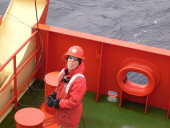Originally from Hamburg, Germany, Steffi did her PhD on Antarctic Foraminifera (Protozoa) at the National Oceanography Centre, Southampton. From there, she moved on to work for the US Antarctic Program in Colorado, supporting scientists deploying on Antarctic research vessels. Her second career change into science publishing has recently brought her back to Germany. She is still in love with Foraminifera, the deep sea and the Antarctic, and writes about Science behind the scenes on Nature Network.
The more we know about something, the more we can see.
Look at the ocean. Sure, it’s pretty when the sun shines and the water is ruffled. It’s impressive when the wind blows and the waves are high. But how much more intriguing is it when you find out why some waves get higher than others? Why the water at some beaches is crystal clear and blue while it is murky and greenish-brown elsewhere? When you find out what organisms cause this colour, what they look like, how they live, and how they are connected to other organisms and components of the system?
When you hear that there is an uncountable number of things in the vast deep ocean that no human has ever seen - and that some of those organisms that we do know about live in ecosystems that are entirely foreign to us, so fundamentally different to what we could have imagined up here where there’s sunlight, such as hydrothermal vents and cold seeps, where the fauna gains their energy to live by using chemicals coming from the depths of the earth?
Science is the quest to find out how things work, how they are connected and how they look from the tiniest detail to the most tremendous forces in the biggest systems.
I am amazed every time I learn something new. Often, these new things are unexpected. They can just be small things, too: clams can swim?
One of my most crystal clear memories is looking through a microscope at a fresh plankton sample for the first time. There was a polychaete wiggling about, decapod larvae at different stages of development, and a cephalopod, almost transparent, rainbow colours pulsating along its body. I would never have seen this without being curious enough to go out with a plankton net, get the sample, and look at it through a microscope - and without the knowledge of what these animals were and how they live, it would just have been a pretty sight.
If we can give a name to something, it makes us appreciate it from a different, much deeper, perspective. With every bit we discover about how things ‘work’, we gain a deeper understanding of the world around us.
We knew this as children. Scientists are like children that have not stopped asking questions. And there is no end to the questions we can ask - if you can’t think of one, just talk to a child.
 Published by
Published by
One Comment
Well, I can agree anywhere, but from the other sight of science :-)
1 TrackBack
The Open Laboratory 2009 - the submissions so far…
Here are the submissions for OpenLab 2009 to date. As we have surpassed 150 entries, all of them, as well as the "submit" buttons and codes, are under the fold. You can buy the 2006, 2007 and 2008 editions...……